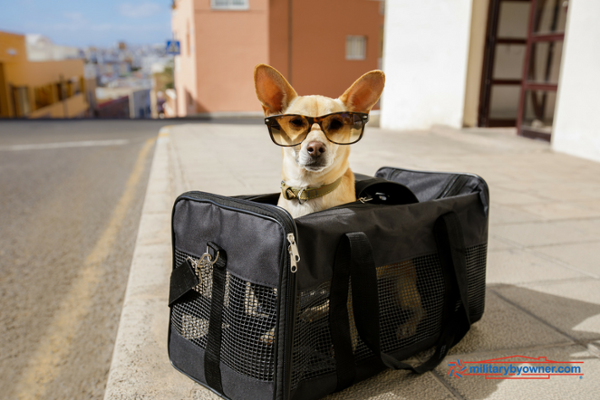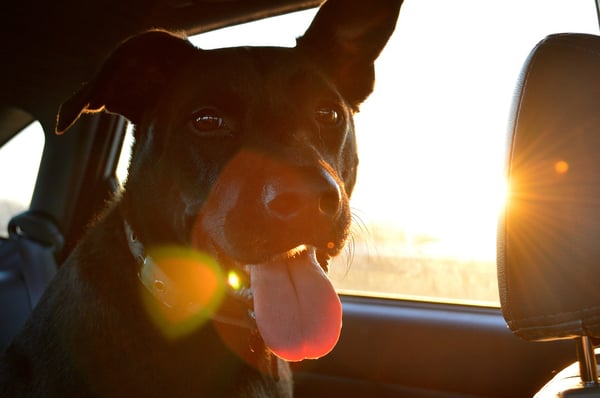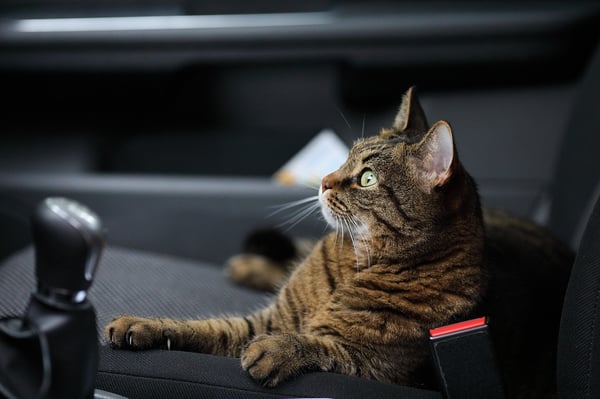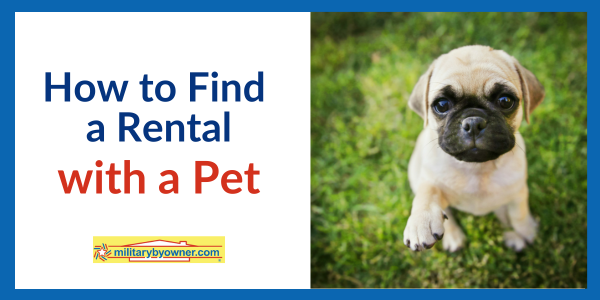8 Tips for a Cross-Country Move with Pets
What a relief; your next PCS move doesn’t require a flight for your pet!
Driving across country or even a few states away weighted down with irreplaceable belongings, kids, and pets doesn’t always sound like a good time, but for anxious pet owners, it beats loading the pet for plane cargo anytime.
But don’t get too comfortable plotting your route just yet. For some, pets are family members, and planning for a move with pets is almost as taxing as planning for a child. Some dogs need even more space.
Planning for a Cross-Country Move with Pets

1) Before You Leave - Preparation Mode for Moving with Pets
Choose a Restraint
Above all else, plan for safety first. Finding the best restraint option is the best way to start thinking about prepping the car for traveling with your pet. Consider this equation cited in the LA Times by Katherine Miller with the ASPCA.
"A pet that weighs 50 pounds, in a 35 mph collision, is projected forward like a cannonball with 1,500 pounds of force, and that can cause critical injuries to the folks in the front seat.”
Successful pet travel takes weeks or months to prepare the animal, especially if the dog or cat is young or hasn’t traveled in a car for long lengths of time. To avoid fear and anxiety, an early introduction to restraining options is ideal.
Crates are usually recommended as the top choice by veterinarians. For small animals like rabbits and guinea pigs, securely fix their enclosures to a stabilizing fixture in the car, like the latches used for baby car seats.
But, if the family is in full PCS mode, space is precious and limited. A crate that correctly fits popular dog breeds such as German Shepard or Golden Retriever won’t fit into most four door cars or station wagons. A pet seat belt attachment that securely snaps into existing seat belts is the next best choice. Add a comfy nest of a blanket or pillow, and hopefully, the dog will relax after a while.

Practice Trips
If your pet is new to travel, schedule practice drives to places they’d like to go, such as a park or trail. Take your pet along on short trips and have a treat ready when they return home.
Don’t let their only car rides equate to a trip to the vet’s office. They’ll immediately catch bad vibes and misbehave.
After several journeys of various lengths, you’ll be able to gauge their fear factor, propensity to car sickness, and general feelings about the car. Some love the ride, others hate it, but most would rather endure than be left behind!
Adjustments to the Car
You’ll likely have the car you’re driving across country serviced for the long road ahead. Don’t forget to inspect the features that also affect your pet’s comfort: adequate AC or heat, ventilation, working windows, and seat belts.
On the day of departure, check the speakers as many will be at the same height level as dog and cat ears. They’ll appreciate moving the music up front, where the humans can hear it better.
Double check the space for the animal. As car loading goes along, their designated area likely gets smaller and smaller.
*Here’s a clean up prevention tip. Do not place any item you wouldn’t want to clean pet puke off near your pet. Car sickness doesn’t discriminate and can affect any pet.
See our extensive resource guide on Moving with Your Pets.
2) Consider Amtrak as an Alternative to Driving
Amtrak’s standard routes and auto train option often surface in PCS research, because the process is military family friendly. Amtrak offers discounted fares for military and has the option to bring your pet along on certain routes in designated cars.
There are several restrictions as to which lines accept them and how the mandatory carriers are placed under your seat, but for those with cats and dogs weighing less than 20 pounds, train travel may be an affordable option.
Here’s more on how to travel with your pet on the rails: Train Travel with Pets: An Amtrak Update.
3) Plan for the Health and Safety of Traveling Pets
Just like traveling with a sick child, traveling with a dog or cat on the mend adds an extra layer of stress. Avoid, or plan well in advance, all surgeries that require many days of recuperation and medicine.
One last check up with your current vet serves as a one stop shop to update vaccines and microchip information (always add a current mobile number), pick up health records, and talk to the doctor about possible fear and nausea relief. Depending on the stress level, they’ll have multiple suggestions, but most vets prefer to avoid sedation. To help start the conversation with the vet, read over Consumer Report’s list for herbal relief, which includes melatonin and lavender oil.
*Use this trip to also snap a current photo of the pet, pertinent health information, and any other identifying features that would be helpful for a search if the pet becomes lost along the way.
Free resource: The Ultimate Guide to Moving with Pets.
4) Pack Travel Gear and Comfort Items
Keep in mind that your pet needs the same items from home to use on the road. They might look a little different, but the functionality remains the same. Routine is helpful and offers security during a stressful time.
- Food and treats
- Travel bowls
- Toys and bedding
- Seat belts, crates, and seat covers
- Access to bottled or stored water from home (to avoid upset stomachs that often come from out of town water)
- Medicines, both daily and preventative
- Collars and leashes
If you have a pet, you’re going to have a mess, probably multiple messes. Keep your clean-up kit stocked and at the ready.
- Cleansing wipes
- Rags to clean up and then throw away
- Beach towels and sheets for protection
- Paper towels
- Fabric cleaner to deodorize and sanitize stains
- Plenty of poop bags
- Travel version of a litter pan
Get more tips in Prepare Now to PCS with Pets this Summer.
5) Tips for Traveling Alone with a Pet
During life in the military, there’s a high probability that either the service member or spouse will travel state to state alone--probably because someone has to transport the pet! It's tricky to navigate a long distance trip alone with a pet in tow. Read on to learn tips for safe solo travel.

Keep in Touch
With tracking and app options for your phone, it's easier than ever to keep your family updated on your journey, but it's still a good idea to have your route mapped and send updates when major off-course occurrences occur. Traveling with a pet means some flexibility has to be built in for frequent breaks. Using an app helps to search pet friendly restaurants, attractions, and dog parks.
Plan for Rest Stops
Traveling alone with a pet takes planning for rest breaks to the next level. Owners struggle with the dilemma of what to do about leaving their pets unattended while they visit the bathroom or try and grab some lunch.
Locking an animal in a hot car is unacceptable and dangerous. But, leaving the windows down for the time it takes to run in and order food could be too long. Dog-napping, escape, and the destruction of your car could be a result!
For solo travelers, there isn’t one perfect solution. Cool weather allows for the pet to hang alone for a bit if they don’t get too stressed. During very cold or hot weather, some owners have the ability to lock the door with the car and AC/heat running. Another option is to locate a pet-friendly store, such as PetSmart, Petco, or Cabela's/Bass Pro Shops. They offer bathrooms (ask staff to hold a pet), snacks, and interesting smells and sights for animals!
*In a pinch, a local veterinarian's office should totally understand your predicament!
Rest stops are hugely helpful for pet owners on the road. They typically have pet relief areas which also offer a bit of play time and exercise. The USA Rest Stop app assists drivers in finding the nearest rest stop or one along your chosen route. The app also features amenities you might be looking for, such as service plazas.
Insurance Plans
If there was ever a time to have an updated roadside assistance plan, it's when traveling alone with a pet. They offer standard roadside services, such as tire changes or towing, but could also rescue your pet if they accidentally lock you out with a front paw!
Pet owners often worry if anyone will attend to their animal if an accident occurs while alone. Tape an envelope with information about who to call and how to seek care for your pet on board. Make it easy for first responders, since even if they find your cell, it could be damaged or locked.
6) Staying in a Hotel with Pets
PCS dates change constantly. This makes scheduling hotel and military lodging that accept pets difficult, especially during the summer and over holiday breaks. Pet-friendly rooms are even more difficult to find when traveling late in the evening without a reservation! Do your best to book rooms and adjust as necessary. Most major hotel chains offer prior to 72 hours of the check-in date as a fee-free cancellation period.
If you need some extra time to make changes, skip the 1-800 number. The front desk staff at the actual property have more flexibility to change cancellation fees due to your extenuating circumstances. (Use your lodging benefit wisely and read Military Lodging for PCS and Vacation Travel.)

Pet owners also run into the problem of inaccurate pet policies posted online. Breed and weight restrictions change frequently and might not be updated. Verify with local staff before making the reservation. No one wants to be turned way late at night after unloading the car, kids, and dog!
*Try to re-create your pet’s sleeping arrangement they normally have at home. Use their bedding and other comforting items for a better night’s rest.
Lookout for Bed Bugs
Across the U.S., the uptick of bed bug infestation in hotel rooms has travelers on edge. It's in the best interest of guests to be aware of the possibility of their presence in every hotel room, no matter the price point. Bed bugs feast on blood, not cleanliness.
Although bed bugs prefer humans, they may bite pets if available. It's far more likely, however, that they’ll hitch a ride in your pet’s bedding and accessories and travel to your next home. Pest control company Terminix recommends techniques for finding evidence of bed bugs in the hotel room, on you, and on your pet.
7) Pay Attention to Pet Etiquette
Pets get a bad rap because they act like animals! Owners should go to great lengths to maintain and clean up after their pets while traveling. The top complaints from non-animal loving people include the lack of poop removal, poor manners (jumping, biting), barking, and plain disregard of the fact they choose not to live a life with a pet.
Do pet lovers everywhere a favor (we want to keep our pet friendly policies!) and stick to pet guidelines in any community place. Leash your pet, especially in unfamiliar places, because anxiety moves dogs to unusual behavior. Have you ever heard, “My dog never bit anyone before!” Always keep extra clean up bags at the ready and do not leave behind dogs and cats that cry when left alone. Your hotel neighbors will be quick to call and report you.
8) Use Technology for Better Pet Travel
Take advantage of that pocket computer you have at all times and load it up with apps and websites that transform a dreaded road trip into a bonding adventure with your pet! A little designed-with-animals-in-mind technology could comfort your pet and make the road trip less scary. (Can you ever be too prepared? See Military Move with Pets: Tips to Prepare)
Apps
- Bring Fido is an industry leader for locating pet-friendly hotels and attractions.
- Red Cross has pet first aid tips.
- Pet Snap is just for fun and utilizes 30 different sounds to hold your pet’s attention while at the same time snapping bursts of photos to document silly faces.
Websites
- Go Pet Friendly has a road trip planner, travel tips, and pet friendly resources.
- The American Animal Hospital Association operates an animal hospital finder.
- Rover connects travelers with on the road pet care (doggy day care, pet boarding) through screened providers in the area.
Tech
- Pet Trackers and GPS Collars provide updated emails and texts when your dog leaves a designated safe place. Some have nationwide coverage in case of a runaway.
- Pet Cube Camera allows owners who are away to interact with their pets who are at home or in a hotel room. Owners communicate through two way audio and have the option to dispense treats from a distance. Catch naughty behavior in real time!
As you prepare for the trip, take into consideration your pet’s personality. They all have quirks. For example, don’t leave animals alone who are prone to separation anxiety, invest in plenty of cleaning wipes for car sick pups, and if need be, give your cat plenty of secure space in a crate if that makes traveling easier.
Military families are pros when it comes time to PCS, but picking up a new trick or two is what continually smooths the process. Browse the collection of blogs dedicated to not only moving but to finding and securing your next (hopefully pet friendly) home!






